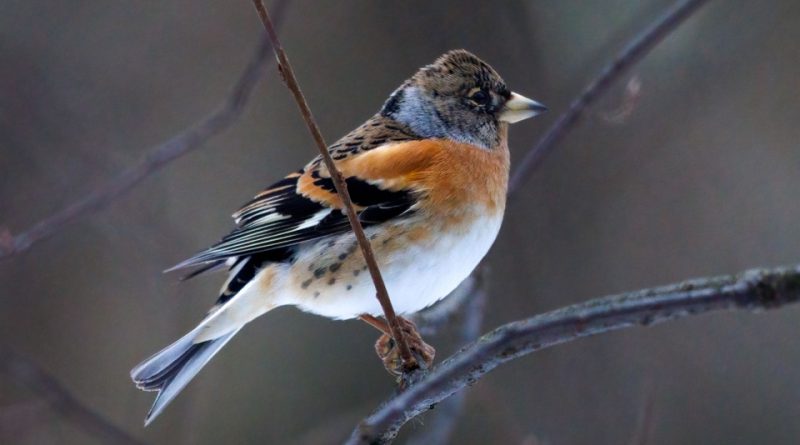Fringilla montifringilla
Fringilla montifringilla
The brambling (Fringilla montifringilla Linnaeus, 1758) is a passerine bird belonging to the Fringillidae family.
Systematics –
From a systematic point of view it belongs to:
Eukaryota Domain,
Kingdom Animalia,
Phylum Chordata,
Subphylum Vertebrata,
Aves class,
Subclass Neornithes,
Superorder Neognathae,
Order Passeriformes,
Suborder Oscines,
Infraorder Passerida,
Superfamily Passeroidea,
Fringillidae family,
Subfamily Fringillinae.
Genus Fringilla.
F. montifringilla species.
Geographic Distribution and Habitat –
The Fringilla montifringilla is a bird that lives on a very vast range, which affects a large part of the Palearctic eco-zone; being a migratory species, the wintering and breeding areas must be identified. The former include practically all of Europe, the Atlas Mountains in North Africa, a wide strip of central-southern Asia ranging from the Anatolian peninsula to Nepal, the coastal strip of China (from the Korean peninsula to the upper reaches of the Azzurro) and Japan: the latter include a large portion of the northern hemisphere from the Scandinavian peninsula to Kamchatka.
Occasionally, isolated specimens are sighted or captured in North America, especially in the northwest of the continent.
In Italy this species is a winter visitor known for not visiting the same sites every year and with some rare cases of nesting in the Alps.
The typical habitat of this species is that of wooded areas, both coniferous and broad-leaved, with the presence of clearings or open spaces and fresh water sources: especially during migrations, they would seem to be closely linked to the presence of beech trees. and birches, at which they choose to stop.
Description –
The brambling is a passerine bird with a weight that varies between a minimum of 17 and a maximum of 30 grams and a length of 14-16 cm.
It has a very distinctive livery with the presence of sexual dichromatism: the males, during the reproductive period, have a black head, back, wings and tail of the same color (with the single feathers that however appear edged with brown on the back and reddish on the wings and tail, with the presence on the first also of the characteristic bars which in the other finches appear white), undertail, under the wing and lower belly white, throat, chest, shoulder blades and reddish flanks (the latter with black spotting). The females, on the other hand, have the black of the males replaced by the brown and the red by the whitish, with the shoulder blades of gray color and the edges of the wing feathers of brown color. In both sexes the eyes are blackish-brown and the paws are flesh-colored, while the beak is yellow and becomes black in the males in love. During the winter, the color becomes paler and dull, especially in males.
This bird therefore has a double moult.
The territorial song is melodious enough for a finch while the contact call is a dry “gnec gnec” repeated in succession.
Biology –
The Fringilla montifringilla is a monogamous species only for the nesting season even if the family group formed during the productive season certainly remains united in the winter flocks.
The mating period runs from May to July.
The nest is built by the female while the male controls and defends the territory from any aggressors or competitors.
The nest is a typical finch cup, sufficiently deep and well-sized built with moss and lichen and lined inside with soft and minute material. The structure is usually located on a bifurcation of a branch but also rests directly on the needles of the conifer at a height of a few meters.
In the nest, built on trees at heights ranging from 3 to 5 meters, from 4 to 6 eggs are usually laid, with a very rare maximum up to 9, of a bluish cream color finely speckled with reddish, which are incubated for about 14 days . from the female.
The chicks are born blind and naked and remain in the nest, assisted by both parents, for another 2 weeks before taking off but are also followed by their parents for a subsequent period. Usually there is only one brood but a second is possible in some years.
It is a species that nests in Northern Europe up to the limits of the arboreal vegetation in Scandinavia, Finland, Russia and Asia, it winters in central and southern Europe, rarely in northern Africa. In Italy it is present during the pass and review period and sometimes wintering.
In Italy, nesting is rare and sporadic as it is on other mountain ranges in central Europe, but always at altitudes such as to reproduce the climatic conditions typical of the usual northern territories.
Ecological Role –
The brambling has a rather varied and generalist diet: it mostly consists of seeds, grains, berries and invertebrates, especially butterflies and beetles. In the case of food of animal origin, these birds would seem to be rather selective regarding the size of the food, tending to choose adults under 6 mm and larvae under 20 mm in maximum size. During the winter the vegetable component is understandably preponderant over the animal one, while in the summer they tend more or less to be equivalent.
It is a bird with diurnal habits, apart from the reproductive period it spends most of its time moving in search of food in flocks that can even number several hundred individuals, sometimes in association with other passerines such as the related finches, buntings and larks.
Its behavior is also territorial and quite solitary during the nesting, to then become incredibly social to migrate, with flocks in waves that follow one another in an almost continuous and incessant way.
According to the IUCN Red List, the species is not currently considered endangered.
Guido Bissanti
Sources
– Wikipedia, the free encyclopedia.
– C. Battisti, D. Taffon, F. Giucca, 2008. Atlas of nesting birds, Gangemi Editore, Rome.
– L. Svensson, K. Mullarney, D. Zetterstrom, 1999. Guide to the birds of Europe, North Africa and the Near East, Harper Collins Publisher, UK.


